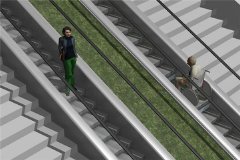Jun 15 2009
People with impaired mobility who move around in wheelchairs, people who are transporting bulky loads and all other users will be able to travel upwards and downwards without assistance using the innovative escalator designed by Jesús Sánchez, a student at the School of Industrial and Aeronautical Engineering of Terrassa (ETSEIAT) of the Universitat Politècnica de Catalunya (UPC). The new escalator design was developed for a final thesis and received awards from the College of Industrial Engineers of Catalonia and the Universia Foundation. It affords savings of energy, construction materials and installation costs.

Conventional escalators do not completely solve accessibility problems for people with impaired mobility such as people using a wheel chair, the elderly, and people with pushchairs or bulky loads. Escalators are just another obstacle that these people have to avoid, often with the help of other people, which requires a great deal of effort and wasted time. ETSEIAT student Jesús Sánchez has designed a new escalator that all users can use self-sufficiently for his final thesis, which was directed by lecturer David Huguet.
How the escalator works
Jesús Sánchez began with an initial concept that is similar to the current escalator design but on which he has made a series of outstanding innovations. Users without impaired mobility will be able to use the escalator in the same way as they use the current ones. However, when a person with impaired mobility who uses a wheelchair needs to use the escalator, he or she will press a button to make three stairs of the escalator move together vertically to form a flat platform that can accommodate the wheelchair. Once the user is on the platform with the wheelchair perfectly positioned the escalator will move until the user reaches the end. When the user leaves the escalator, the platform will convert back into three independent stairs.
Jesús Sánchez has also thought of a remote command system for people with disabilities who due to physical limitations would not be able to press a button to activate the platform. This innovative escalator design also incorporates light and acoustic signal systems to enable people with vision or hearing impairments to use it.
User safety is another important element of the design. The escalator includes a backup battery system to supply energy in the case of a power cut when the user is in the middle of the trip so that the user will always be able to reach their destination without problems.
Energy and cost savings
The stair belt that moves between the upper and lower levels of the slope is the same for the ascent as it is for the descent. That is, it works with a closed circuit, similar to the luggage transporters at airports, but on a slope, which means the same escalator can be used for transporting people in both directions. Current escalators require one installation for ascent and another for descent because the stair belt is designed for movement in a single direction only. According to the creator of the innovative design, "the main technical difficulty that I had to overcome was to find a way to make the stairs turn at the end of the slopes, but in the end I managed it".
The system designed by Jesús Sánchez saves on energy and the costs of installation and materials when compared with current systems. He reckons that the energy saving obtained will be 30% compared with current escalators and that the economic saving will be 35%. "Often municipal councils and companies think of lifts as the way to provide access for people with disabilities who have impaired mobility, but my system is cheaper and more sustainable than installing a lift. It is a design that solves accessibility problems in areas with slopes, where the typical solution would be to install steps and, although this is often very expensive or practically impossible, a lift", says Jesús Sánchez.
5.6 million people with mobility difficulties
This is a much-needed design because in Spain today there are 3.5 million people with some kind of disability and 5.6 million people who have difficulty walking up or down stairs. Other beneficiaries might be people with circumstantial mobility difficulties caused by a shopping cart, pushchair, ambulance stretcher, etc. For this reason, Jesús Sánchez and lecturer David Huguet from the UPC Terrassa Campus got to work on designing a new concept in escalators that is suitable for all users.
A patented design seeking investors
At this time the author has already received the award for the most creative final thesis at the ETSEIAT from the College of Industrial Engineers of Catalonia. The design is also patented and now investors must be found to fund the construction of this innovative escalator.